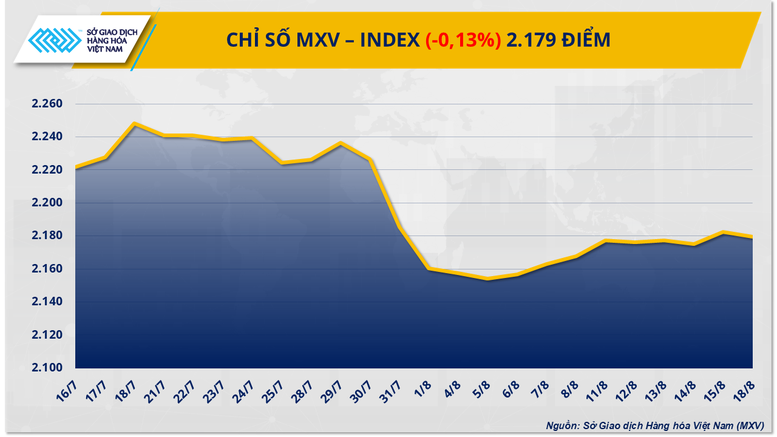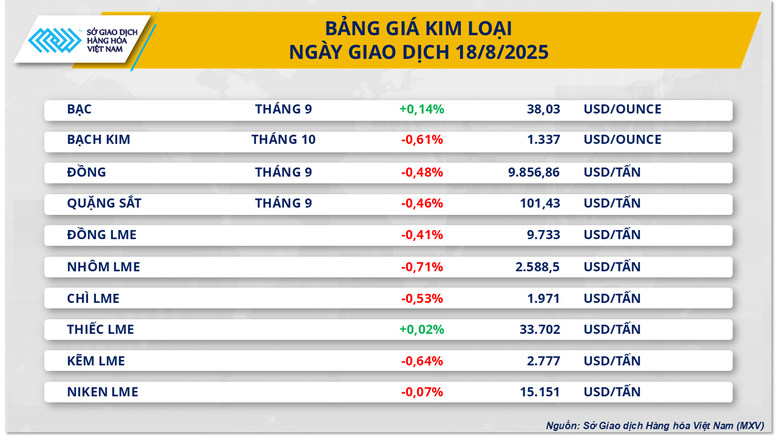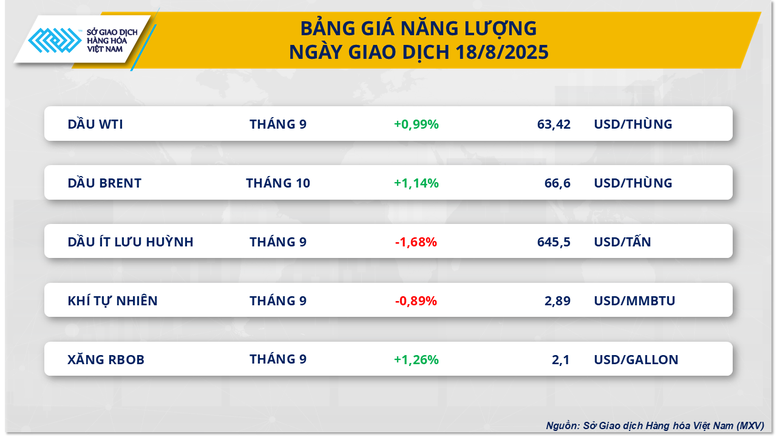
The world raw material market opened the new week with mixed developments. According to the Vietnam Commodity Exchange (MXV), the MXV-Index closed down slightly by 0.1% to 2,179 points with selling pressure dominating.
In the metals market, iron ore prices fell for the fourth consecutive session under pressure from weakening demand from China. On the contrary, concerns about supply disruptions from Russia returned, thereby supporting oil prices to rebound during the session.
Pressure from China drags iron ore prices down for fourth consecutive session
At the end of the first trading session of the week, the metal market witnessed overwhelming selling pressure when 8/10 commodities simultaneously decreased in price. The September iron ore futures contract extended its decline to the fourth consecutive session, falling nearly 0.5% to 101.43 USD/ton.

According to MXV, iron ore prices are under pressure mainly from weakening demand in China – the world’s largest steel consumer. Pig iron production in July fell 1.4% to 70.8 million tonnes, while crude steel fell 4% to below 80 million tonnes, the lowest level since the beginning of the year. Cumulatively for the first seven months, crude steel production fell 3.1% year-on-year, reflecting a slowdown in input demand.
The underlying cause is the continued decline of China’s real estate market: Investment fell 12%, home sales fell 4%, and new construction began a 19.4% drop in the first seven months of the year. This has caused a sharp decline in demand for construction steel, and thus iron ore.
China’s steel industry is facing difficulties not only in domestic consumption but also in the international market. Japan has just initiated an anti-dumping investigation into galvanized steel imported from China, while India is considering a similar move on alloy steel coil. These trade barriers are likely to limit Chinese steel exports, further curbing demand for iron ore.
In addition, the USD increased by 0.32% to 98.17 points, also contributing to increasing pressure, making iron ore more expensive for customers outside the US.
Domestically, finished steel prices have remained stable since the beginning of July, with CB240 coil steel around VND13.23 million/ton and D10 CB300 rebar steel at VND12.83 million/ton.
Oil prices recover amid concerns about supply disruption from Russia
According to MXV, the energy market was relatively quiet in yesterday's trading session as investors paid attention to the latest developments related to the meeting between US President Donald Trump, Ukrainian President Volodymyr Zelenskiy and European leaders at the White House.

After the meeting, both US and Ukrainian leaders gave positive feedback and expressed their hope to continue promoting negotiations in the coming time, including the possibility of holding a trilateral meeting with the participation of Russian President Vladimir Putin, to move towards resolving the Russia-Ukraine conflict that has lasted for more than 3 years.
The market is still waiting for further developments, especially announcements related to the meeting between the leaders of Russia and Ukraine. However, world oil prices still recorded a recovery of about 1% in yesterday's session. Specifically, Brent oil closed at 66.6 USD/barrel, corresponding to an increase of about 1.14%; while WTI oil also increased by nearly 1%, to 63.42 USD/barrel.
The main reason for the increase in oil prices is believed to be due to concerns about the risk of supply disruption from Russia, following a recent statement by White House Senior Advisor Peter Navarro. He continued to criticize India's import of Russian crude oil, while reaffirming that the world's second-largest crude oil importer needs to look for alternative sources.
Oil prices also received support from the risk of supply disruptions via the Druzhba pipeline to Hungary and Slovakia, following a series of attacks on energy facilities in Russia. The market is closely monitoring the moves of the US Federal Reserve (Fed), especially signals about the possibility of adjusting interest rates in the near future.
In another development, natural gas prices in the US continued to decline in yesterday's trading session, with the closing price on the NYMEX floor anchored at 2.89 USD/MMBtu. The main reason came from the sharp decline in input demand of power plants. According to the Edison Electric Institute's report, total electricity output in the US in the week ending August 9 decreased by 1.9% compared to the same period last year. In addition, pressure from the continuously increasing natural gas inventory also contributed to the decline in prices of this commodity.
Source: https://baochinhphu.vn/gia-dau-phuc-hoi-truoc-lo-ngai-dut-gay-nguon-cung-tu-nga-1022508191121377.htm























![[Photo] General Secretary To Lam and President Luong Cuong attend the handover ceremony of the Presidential Office Headquarters](https://vphoto.vietnam.vn/thumb/1200x675/vietnam/resource/IMAGE/2025/8/19/a37cfcbd301e491990dec9b99eda1c99)

![[Photo] Close-up of the first International Financial Center building in Ho Chi Minh City](https://vphoto.vietnam.vn/thumb/1200x675/vietnam/resource/IMAGE/2025/8/19/3f06082e1b534742a13b7029b76c69b6)


![[Photo] General Secretary To Lam attends the inauguration and groundbreaking ceremony of 250 projects to celebrate National Day](https://vphoto.vietnam.vn/thumb/1200x675/vietnam/resource/IMAGE/2025/8/19/3aa7478438a8470e9c63f4951a16248b)
![[Photo] President Luong Cuong's wife and Queen of Bhutan visit Tran Quoc Pagoda](https://vphoto.vietnam.vn/thumb/1200x675/vietnam/resource/IMAGE/2025/8/19/62696af3852a44c8823ec52b03c3beb0)

![[Photo] General Secretary and Prime Minister visit the National Exhibition and Fair Center](https://vphoto.vietnam.vn/thumb/1200x675/vietnam/resource/IMAGE/2025/8/19/f4503ad032d24a90beb39eb71c2a583f)



































































Comment (0)